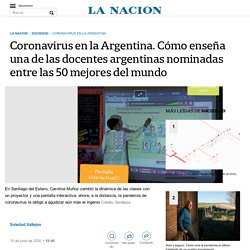

Coronavirus en la Argentina. Cómo enseña una de las docentes argentinas nominadas entre las 50 mejores del mundo. Soledad Vallejos 15 de junio de 2020 • 18:46 Cuando Carolina Muñoz se enteró de que había sido seleccionada entre los 50 mejores maestros del mundo, no pensaba en otra cosa más que en abrazar a sus alumnos y celebrar con ellos.

Pero la noticia llegó dos días después de que se suspendieran las clases en todo el país, el 16 de marzo pasado, y el festejo -como casi todo en medio de la pandemia del coronavirus - le "quedó atravesado". Junto con la docente santafesina Mariela Guadagnoli, también Carolina Muñoz fue elegida entre más de 12.000 maestros de 140 países que participaron de la última edición del Global Teacher Prize, conocido también como el "Nobel de la e ducación" por el millón de dólares que entrega a su ganador. De esos 50 quedarán en carrera solo diez, y la lista con los nombres de los finalistas se conocerá en agosto próximo.
En Bandera, cuenta la docente, el 80 % de los chicos que va a la escuela vive en situación de vulnerabilidad . Un paseo virtual por el mundo. TeachingEnglish Webinar on remote teachers PDF. Teaching online - if the tech fails and structuring lessons. About the webinar The British Council is committed to supporting the use of technology for the continuation of education in a crisis.

As many teachers find themselves in an unfamiliar situation of having to teach their classes online, with little or no experience, the British Council TeachingEnglish website is committed to providing as much support as possible to help you navigate your way through the world of online teaching. This is the second in a series of three webinars, which offers guidance in key areas. This webinar focuses on: What to do if the technology fails and transferring some of the course elsewhere Lesson structure and task-types Each presentation will last for approximately 20 minutes, followed by an extended Q&A clinic. See information about the other webinars in this series: About the speakers Helen Strong is a Life and Career Coach based in the Outer Hebrides off the northwest coast of Scotland.
With thanks to The Consultants-E for their support in organising this webinar. YL Online teaching. YL Online teaching. Innovations in Education Remote Teaching V8 1 164 WEB. Covering Digital Customer Experience & Customer Data Management Excellence. Why Remote Learning and Online Learning Are Not the Same. When enterprises finally started sending people home because of the coronavirus, Gartner undertook a survey of 800 global HR executives to find out to what degree remote working had become a reality.

The survey indicated that 88% of organizations have encouraged or required employees to work from home, regardless of whether they showed coronavirus-related symptoms.Nearly all organizations (97%) had, even then, canceled work-related travel, more than an 80% increase on the two weeks that preceded. In a statement Brian Kropp, chief of research for the Gartner HR practice said of the findings: “As the COVID-19 crisis disrupts organizations across the globe, HR leaders must respond quickly and comprehensively, considering both immediate and long-term talent consequences.”
The Importance of Training While there are many work-related changes that enterprises and workers will experience, one of them will be the need to introduce online, or remote, training in order to keep existing talent. 1. The Difference Between Emergency Remote Teaching and Online Learning. Well-planned online learning experiences are meaningfully different from courses offered online in response to a crisis or disaster.

Colleges and universities working to maintain instruction during the COVID-19 pandemic should understand those differences when evaluating this emergency remote teaching. Due to the threat of COVID-19, colleges and universities are facing decisions about how to continue teaching and learning while keeping their faculty, staff, and students safe from a public health emergency that is moving fast and not well understood. Many institutions have opted to cancel all face-to-face classes, including labs and other learning experiences, and have mandated that faculty move their courses online to help prevent the spread of the virus that causes COVID-19. The list of institutions of higher education making this decision has been growing each day.
The temptation to compare online learning to face-to-face instruction in these circumstances will be great. Table 1. M. The Differences Between Online Learning vs. Emergency Remote Teaching. There is a difference, Brown says, between true online education and the sudden, stopgap shift in which higher education institutions are currently engaged.

What’s occurring at present, he explains, is a rush job — an effort to mitigate the losses students and universities might experience were they forced to completely abandon a semester’s worth of work. “Researchers in educational technology, specifically in the subdiscipline of online and distance learning, have carefully defined terms over the years to distinguish between the highly variable design solutions that have been developed and implemented: distance learning, distributed learning, blended learning, online learning, mobile learning, and others,” notes the EDUCAUSE report. “Yet an understanding of the important differences has mostly not diffused beyond the insular world of educational technology and instructional design researchers and professionals.”
MORE ON EDTECH: Here's the Best Zoom Remote Learning Tech Tips. The Differences Between Online Learning vs. Emergency Remote Teaching.